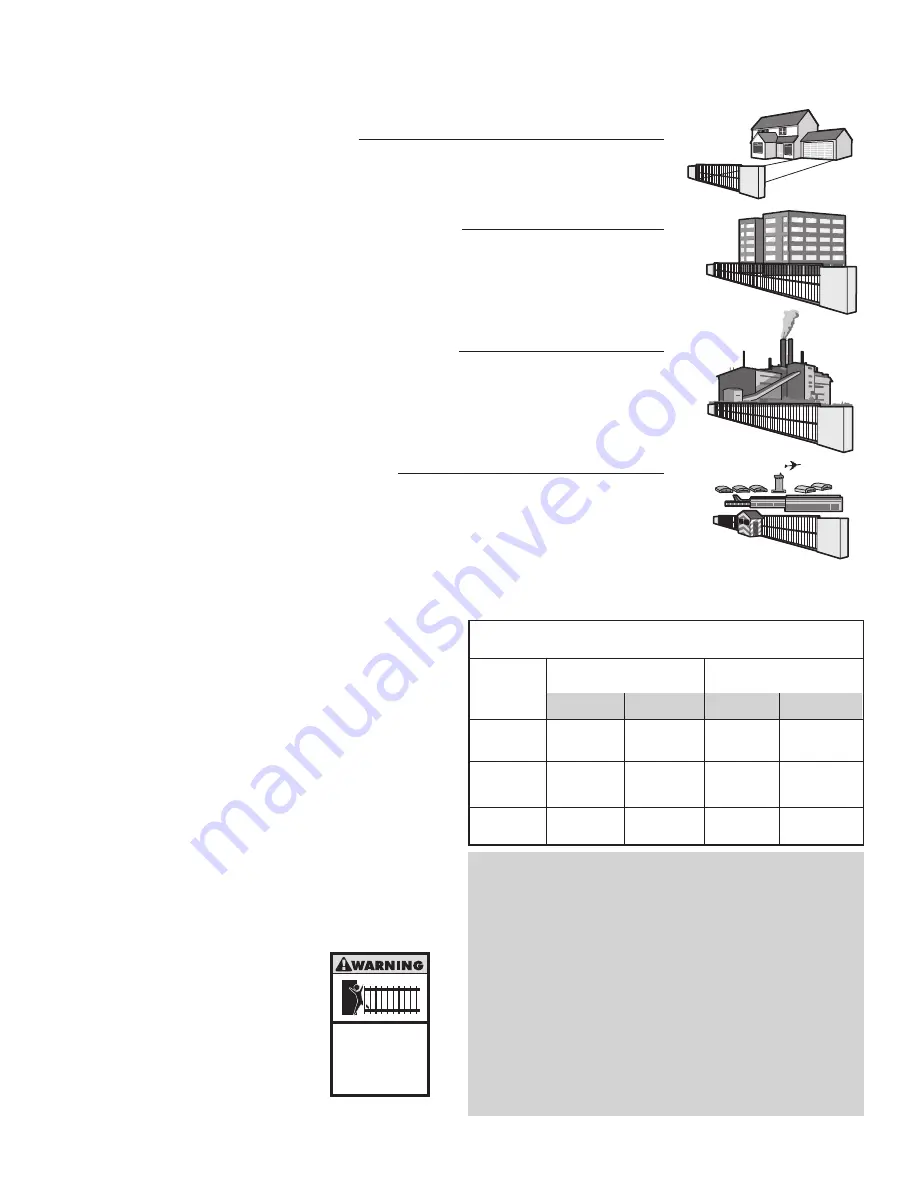
3
CLASS I – RESIDENTIAL VEHICULAR GATE OPERATOR
A vehicular gate operator (or system) intended for use in a home of one-to four single family dwellings, or a garage or
parking area associated therewith.
I
II
III
IV
CLASS II – COMMERCIAL/GENERAL ACCESS VEHICULAR GATE OPERATOR
A vehicular gate operator (or system) intended for use in a commercial location or building such as a multi-family housing unit
(five or more single family units) hotel, garage, retail store or other building servicing the general public.
CLASS III – INDUSTRIAL/LIMITED ACCESS VEHICULAR GATE OPERATOR
A vehicular gate operator (or system) intended for use in a industrial location or building such as a factory or loading dock
area or other location not intended to service the general public.
CLASS IV – RESTRICTED ACCESS VEHICULAR GATE OPERATOR
A vehicular gate operator (or system) intended for use in a guarded industrial location or building such as an airport security
area or other restricted access locations not servicing the general public, in which unauthorized access is prevented via
supervision by security personnel.
SAFETY ACCESSORY SELECTION
All UL325 compliant LiftMaster gate operators will accept external entrapment
protection devices to protect people from motorized gate systems. UL325 requires
that the type of entrapment protection correctly matches each gate application.
Below are the six types of entrapment protection systems recognized by UL325 for
use on this operator.
ENTRAPMENT PROTECTION TYPES
Type A:
Inherent obstruction sensing system, self-contained within the operator.
This system must sense and initiate the reverse of the gate within two
seconds of contact with a solid object.
Type B1: Connections provided for a non-contact device, such as a photoelectric eye
can be used as a secondary protection.
Type B2: Connections provided for a contact sensor. A contact device such as a gate
edge can be used for secondary protection.
Type C:
Inherent adjustable clutch or pressure relief valve.
Type D: Connections provided for a control requiring continuous pressure to
operate the operator open and close.
Type E:
Built-in audio alarm. Examples include sirens, horns or buzzers.
NOTE:
UL requires that all installations must have
warning signs placed in plain view on both sides of the
gate to warn pedestrians of the dangers of motorized
gate systems.
Moving Gate Can Cause
Injury or Death
KEEP CLEAR!
Gate may move at any
time without prior warning.
Do not let children operate the gate or
play in the gate area.
This entrance is for vehicles only.
Pedestrians must use separate entrance
The chart above illustrates the entrapment protection requirements for each of the
four UL325 classes.
In order to complete a proper installation you must satisfy the entrapment
protection chart shown above. That means that the installation must have one
primary means of entrapment protection and one independent secondary means of
entrapment protection. Both primary and secondary entrapment protection
methods must be designed, arranged or configured to protect against entrapments
in both the open and close directions of gate travel.
For Example:
For a slide gate system that is installed on a single-family
residence (UL325 Class I) you must provide the following: As your primary type of
entrapment protection you must provide Type A inherent (built into the operator)
entrapment sensing and at least one of the following as your secondary
entrapment protection: Type B1- Non-contact sensors such as photoelectric eyes,
Type B2- Contact sensors such as gate edges or Type D- Constant pressure control.
Class
I & II
Class III
Class IV
A, B1, B2, C or D A, B1, B2, C, D or
E
A, B1, B2, D or E
A, B1, B2 or D
A, B1 or B2
A, B1, B2, D or E
A, B1, B2 or C
A, B1, B2, or C
A or C
B1, B2 or D
A
Slide Gate Operator
Swing & Gate Barrier
(Arm) Operator
UL325
Installation
Class
Primary
Type
Secondary
Type
Secondary
Type
Primary
Type
A, B1, B2, C, D
or E
SAFETY »
UL325 MODEL CLASSIFICATIONS
GATE OPERATOR ENTRAPMENT PROTECTION
UL325 MODEL CLASSIFICATIONS
UL325 ENTRAPMENT PROTECTION REQUIREMENTS





















